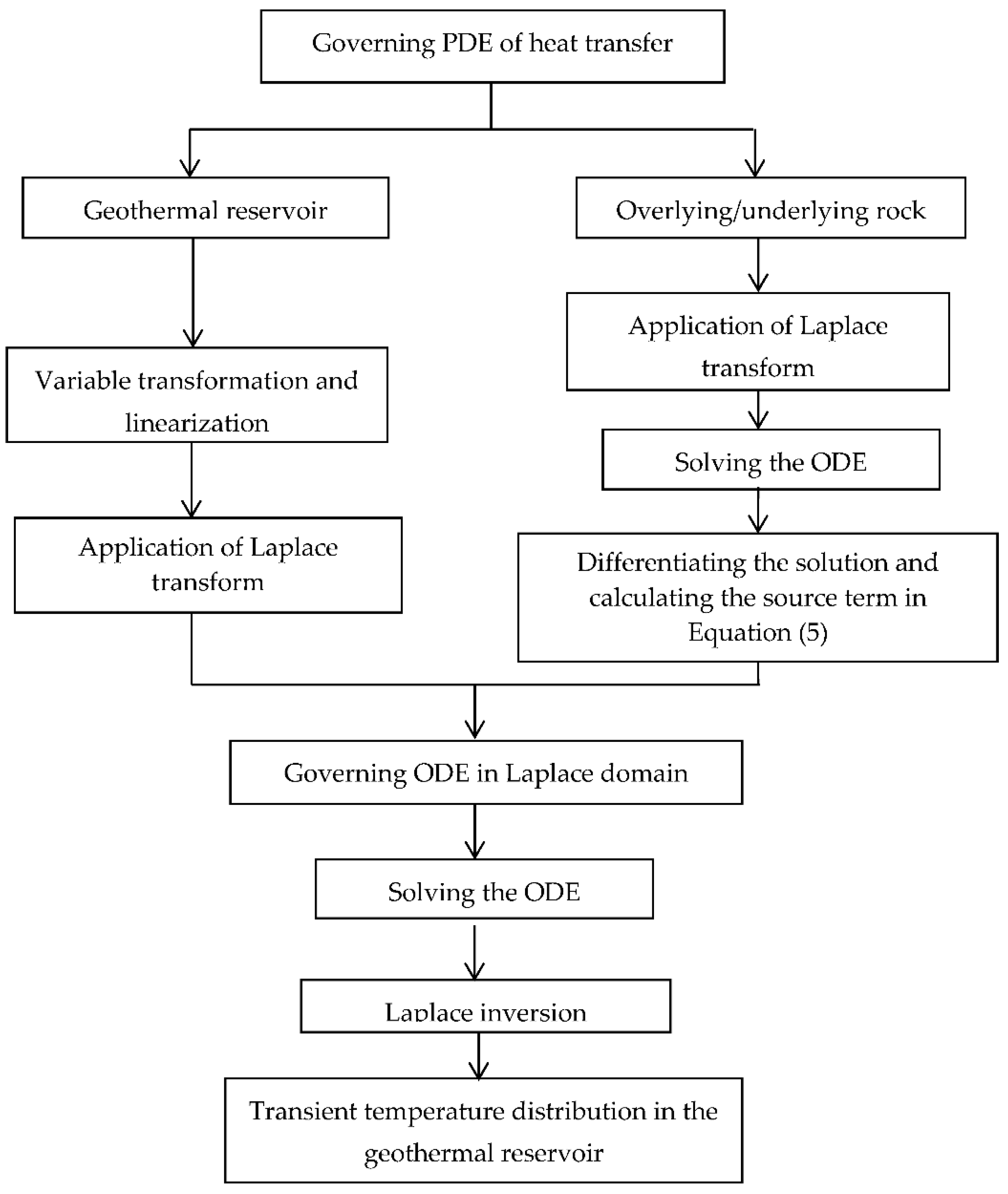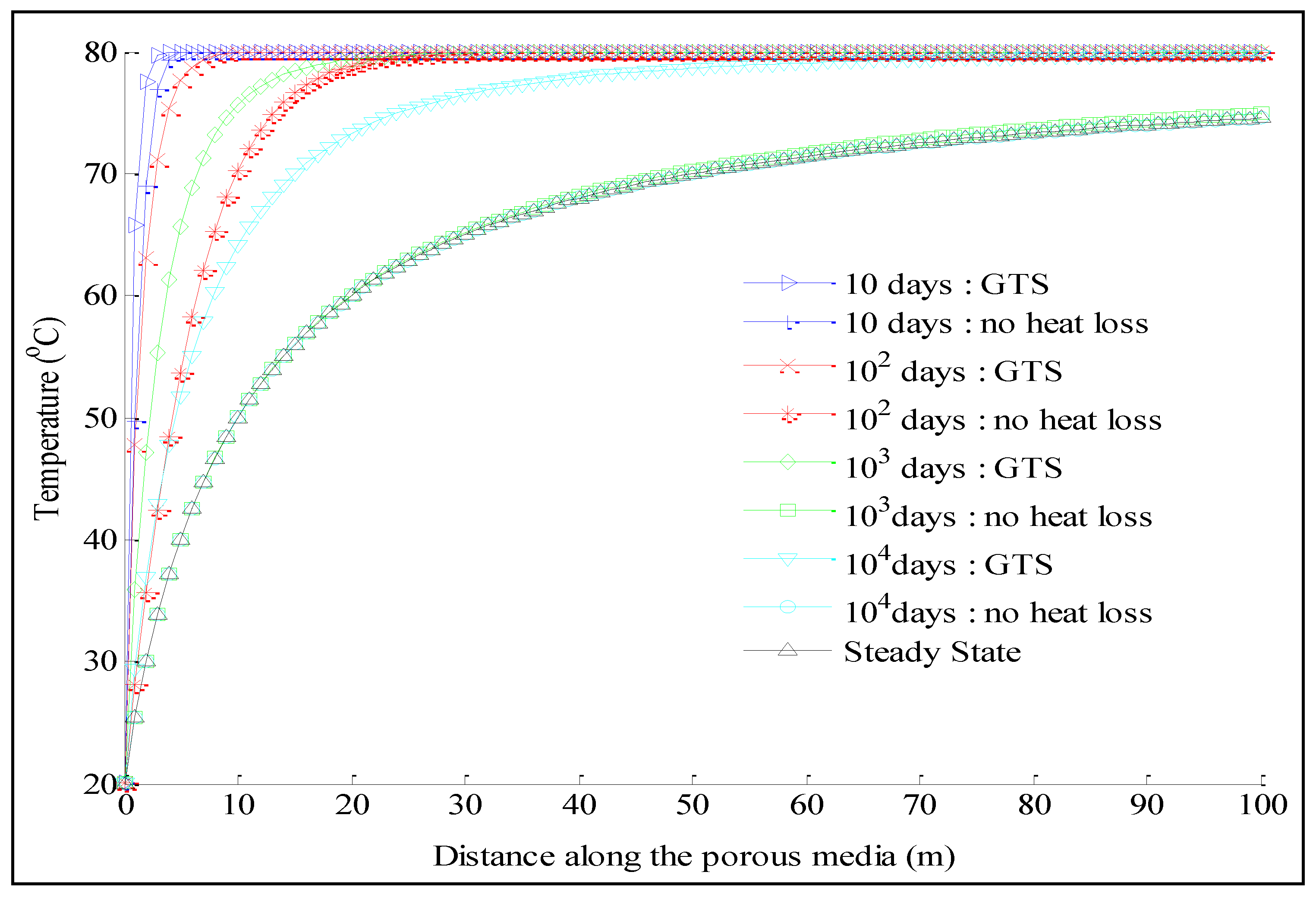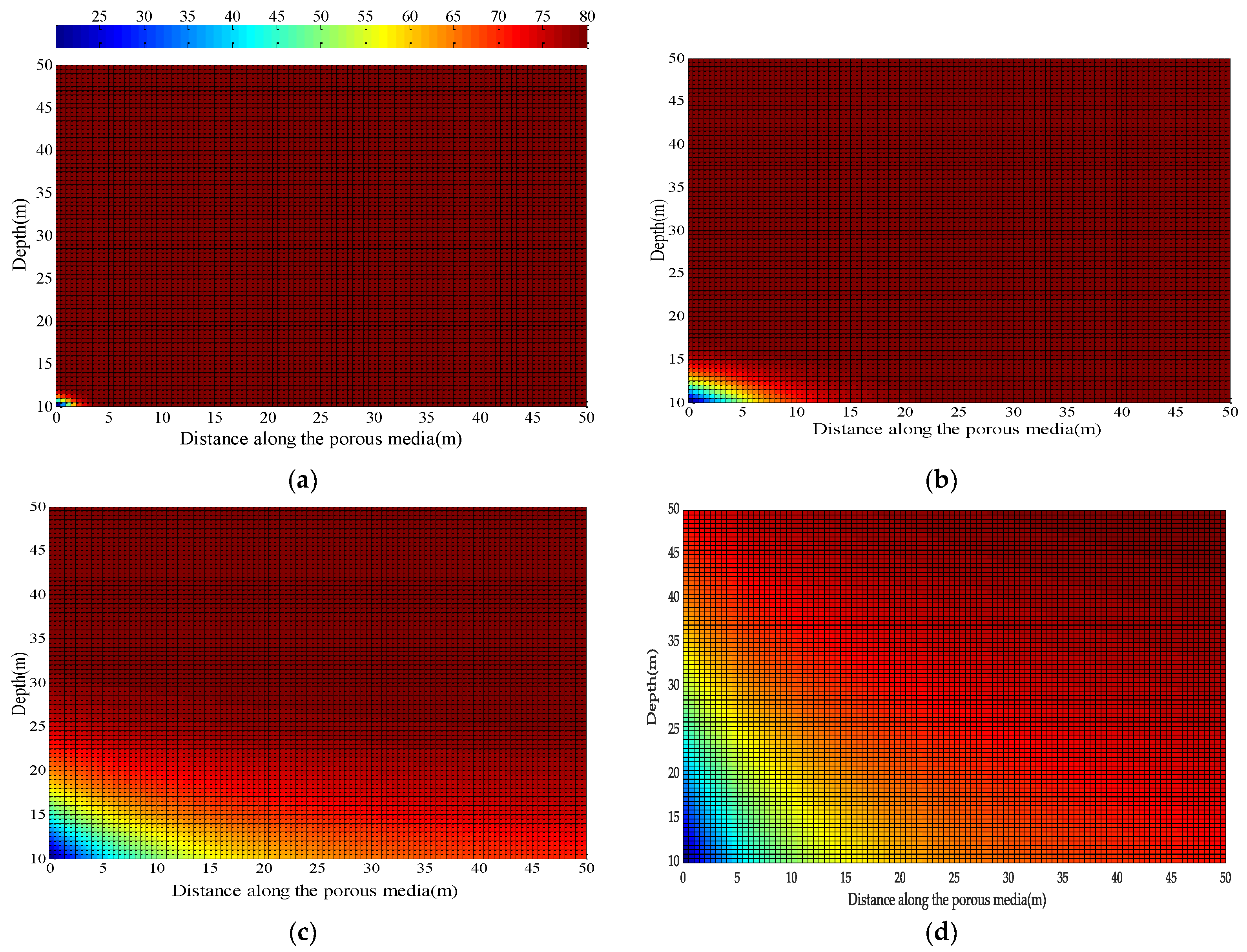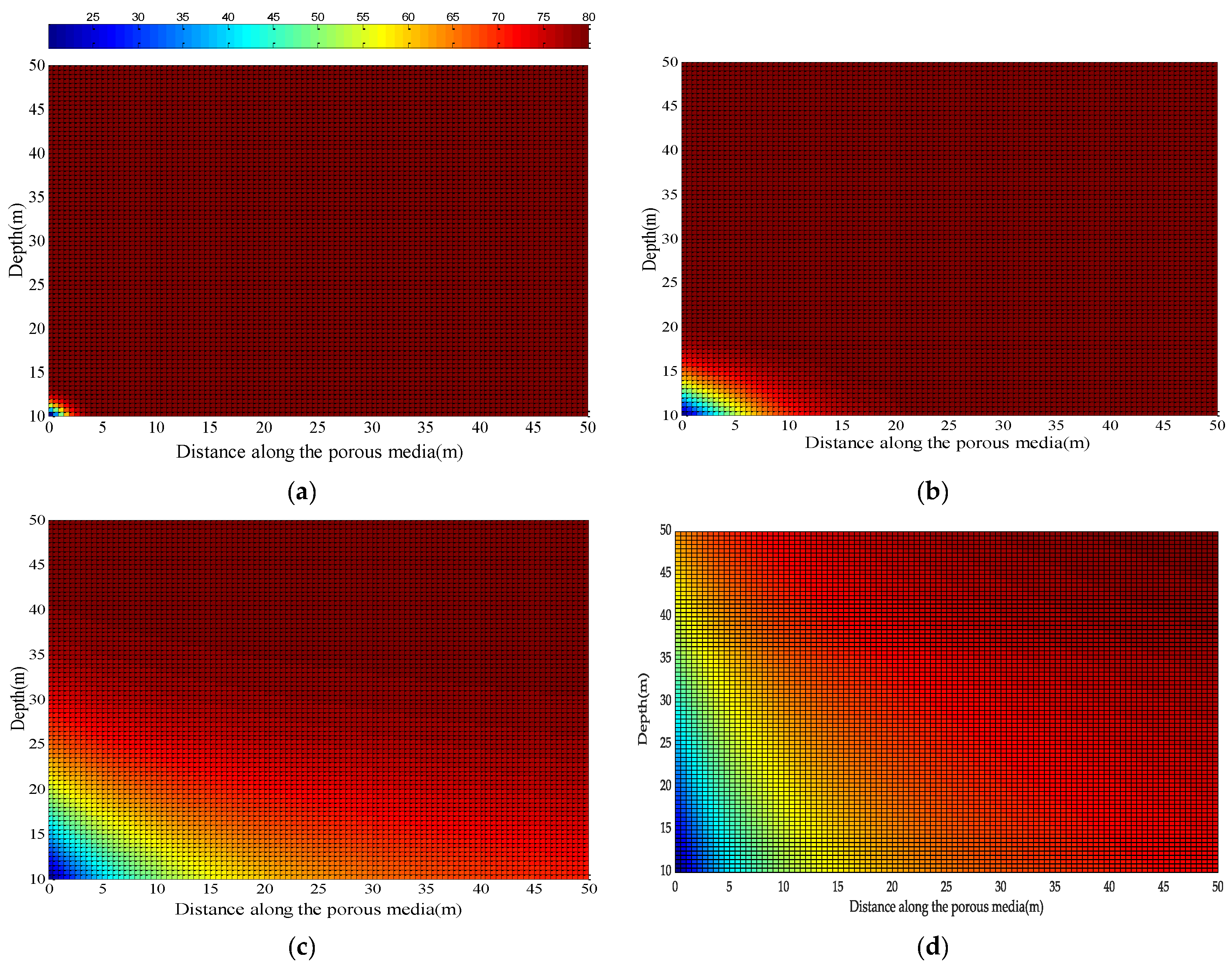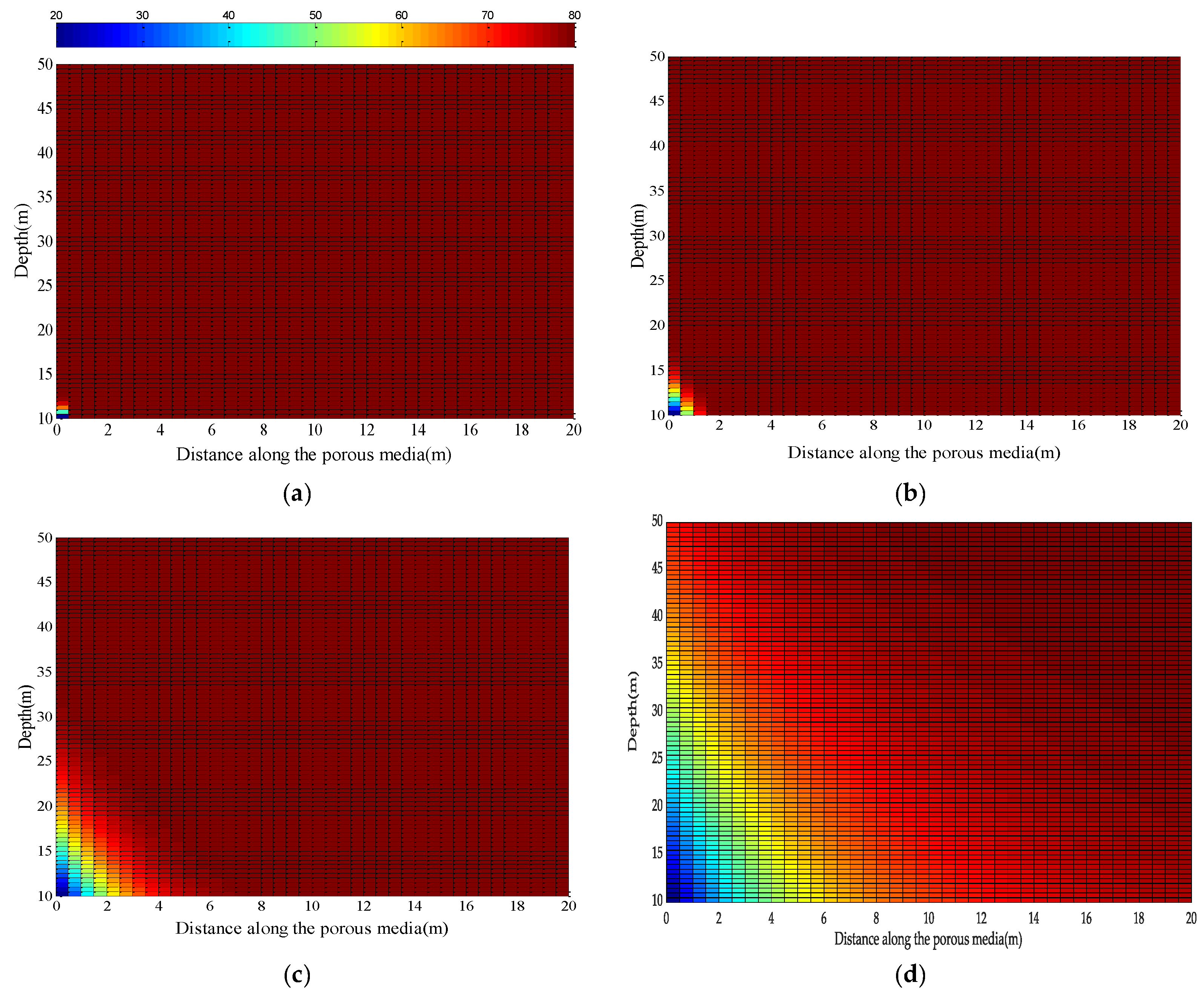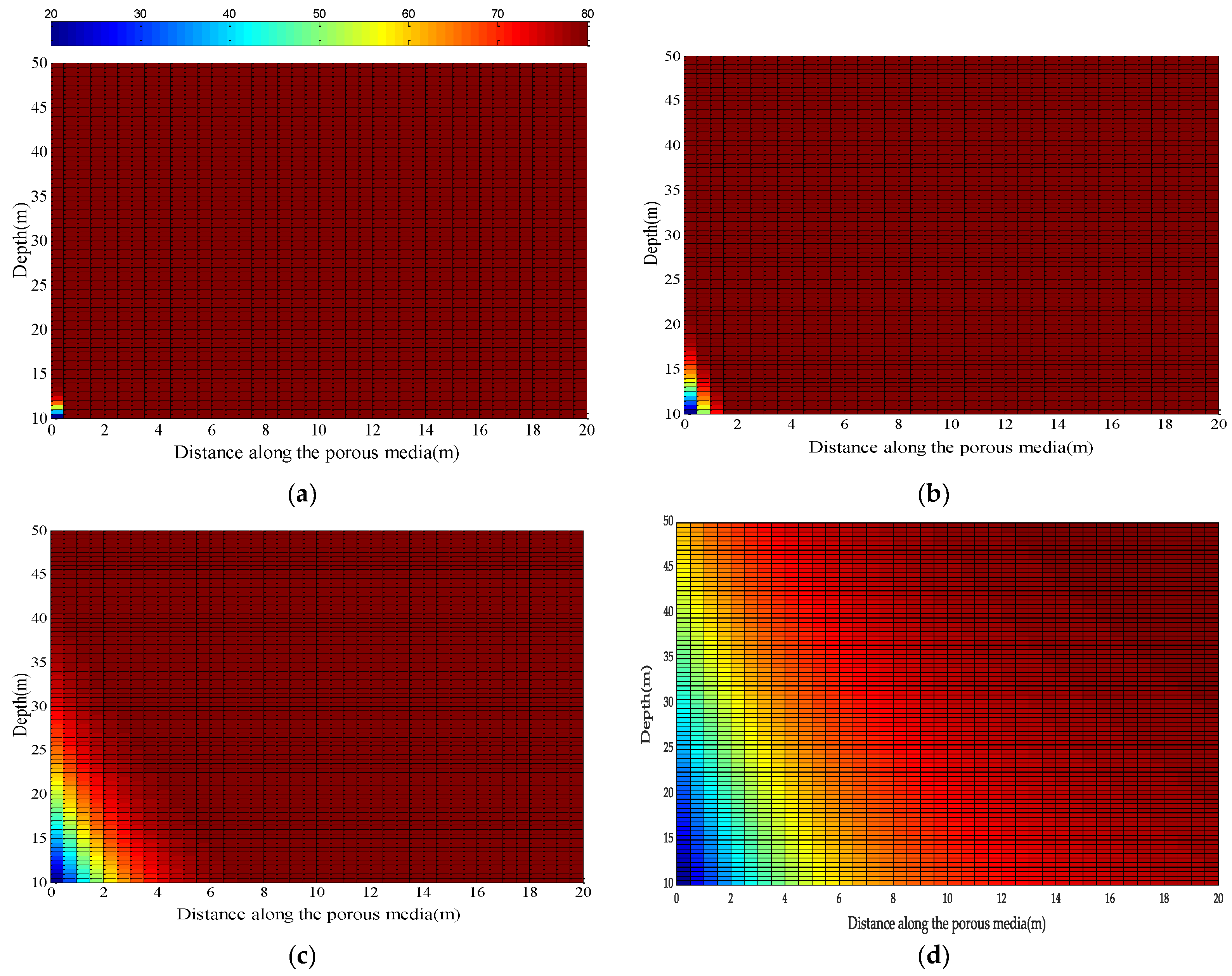1. Introduction
The generation and movement of the cold water thermal front inside a geothermal reservoir, due to reinjection of heat depleted water after power production, is a very important phenomenon to consider in designing the injection production well scheme of a geothermal power plant [
1,
2]. Reinjection of geothermal water after power generation is an essential procedure in maintaining the reservoir pressure, as well as the extraction efficiency, of a geothermal reservoir. But this in turn is responsible for cooling the reservoir with the passage of injection time. Geothermal reservoirs are frequently confined by impermeable rock layers above and below, which play a crucial role in the heat transport process that takes place due to the cold water injection. Besides advective and conductive heat transfer in the geothermal aquifer, another heat transfer process involved physically is heat loss to the confining rock layers. Being impermeable, the advective heat transport in the rock layers can be neglected, and the sole mode of heat transport consists of conductive flux to the rocks, due to the vertical temperature gradient between the geothermal aquifer and the rock media.
The phenomenon of the movement of a cold water thermal front in a geothermal reservoir has been studied analytically by a few researchers. A simple analytical model was developed by Bodvarsson [
3] for the movement of the thermal front due to cold water injection, both for rocks with intergranular flow, as well as fracture flow. The author also discussed practical problems related to the siting of injection wells. Bodvarsson and Tsang [
4] presented an analytical model to study the heat transfer phenomenon due to cold water injection into a geothermal reservoir with equally spaced horizontal fractures. A numerical study was also performed to verify the impact of the assumptions of the analytical model on the solution, which showed that the assumption of negligible horizontal conductive heat transport leads to an erroneous temperature distribution after a long time. Chen and Reddell [
5] developed an analytical model for an aquifer thermal energy storage (ATES) system, which considered injection of hot water into a confined aquifer overlain and underlain by rock media. Two unsteady solutions were derived, one for a long time period and another for a short time period. The authors proposed a graphical technique for evaluating the aquifer thermal properties, like the longitudinal thermal conductivity and heat capacity of the aquifer, vertical thermal heat conductivity and the heat capacity of the caprock. Stopa and Wojnarowski [
6] presented an analytical model, using the method of characteristics, to study the thermal front velocity of cold water injected into the geothermal reservoir. The authors considered the heat capacity and density of rock and water to be dependent on temperature, and neglected the longitudinal heat conduction. Yang and Yeh [
7], Li et al. [
8] and Yeh et al. [
9] investigated the transient temperature behavior of an ATES system for a confined aquifer, bounded by rock media of different geological properties from above and below, by semi-analytical solutions using the Laplace transform. The authors used a numerical inversion technique, by numerical routine DINLAP, to derive their solutions, which approximates the Laplace inversion. An analytical solution for transient temperature distribution due to injection of heat depleted water into deep geothermal reservoirs is reported by Ganguly and Mohan Kumar [
1], who developed a closed form analytical solution for the geothermal reservoir and also analyzed the sensitivity of a few parameters influencing heat transport in porous media.
Although there are a handful of analytical models existing in the literature, there are a very few which address the heterogeneity of a geothermal aquifer. Homogeneous aquifers are very rare in nature, and to present the actual scenario, it is essential to take into account the heterogeneity, because it has an important influence on the heat transport phenomenon in porous media. In a recent paper, Ganguly et al. [
10] derived an analytical solution for a geothermal reservoir with block or layered heterogeneity. The present paper describes an analytical model of the transient thermal behavior due to injection of cold water into a geothermal aquifer with continuous heterogeneity, underlain and overlain by impermeable rock layers. Determination of the transient temperature distribution for a geothermal reservoir is necessary for designing the injection-production well scheme and fixing the flow rates through the wells. A one-dimensional heat transport equation in a porous geothermal aquifer, involving advective, conductive and heat loss (sink) terms, has been solved in order to derive complete and closed form solutions using the Laplace transform technique. As the solution is completely analytical, approximations or difficulties with the numerical Laplace inversion are avoided.
2. Mathematical Formulation
The mathematical model presented here is a set of coupled partial differential equations (PDEs), one for the confined porous geothermal reservoir and one each for the overlying and underlying rock layers. A schematic of the problem domain is shown in
Figure 1. The coupling between the differential equations is ensured by the continuity of temperature at the interface of the geothermal reservoir with the confining layers. The one-dimensional heat transport equation for single phase fluid flow in a porous aquifer, involving advection, longitudinal conduction and heat transfer to the underlying and overlying rock media (source terms), is given by
where
and
are the densities of the rock and water, respectively;
and
are the heat capacities of rock and water, respectively;
is the porosity of the geothermal reservoir;
is the temperature,
is the velocity of groundwater;
q1 and
q2 are the source terms of heat loss from the geothermal reservoir to the overlying and underlying rocks, respectively;
is the injection time and
represents the longitudinal direction.
is the effective thermal conductivity porous media;
is injection time and
represents the longitudinal direction. The assumption of thermal equilibrium is applicable in the above differential equation.
The heterogeneity in the geothermal reservoir is expressed by a spatial variation of velocity [
2,
11,
12] in a finite domain
where
is the parameter of small magnitude accounting for the heterogeneity of the medium,
is the flow velocity at the point of injection. The parameter
is a dimensionless parameter of small magnitude. From Equation (2) it is evident that at the flow velocity through the porous media is
at the injection well, which slowly and linearly increases along the distance due to the heterogeneity of the porous media. The small magnitude of the parameter
and thus the parameter
ensures that the velocity in the porous media is in the Darcy regime. The effective thermal conductivity (
) of the porous media, which is the dispersion parameter of the advection-dispersion in Equation (1), is considered to be proportional to
[
2], as suggested by [
13,
14]
The differential equation describing the heat transport in the overlying and underlying rock is
where subscripts 1 and 2 refer to overlying and underlying rocks, respectively.
.
The source terms, i.e., the heat loss from the geothermal aquifer to the confining rock media at their interfaces
, are modeled by Fourier’s law of heat conduction. If it’s considered that the heat flux to the rock media is proportional to the vertical temperature gradient between the geothermal aquifer and the rock layers, this leads to
where
are the temperatures of the overlying and underlying rock. Substituting Equation (5) into Equation (1), we have the differential equation describing the transient heat transport phenomenon in the geothermal aquifer due to cold water injection
The initial and boundary conditions for the heat transfer Equation (6) for the geothermal aquifer in a semi-infinite domain are given by
The initial and boundary conditions for the heat transfer, Equation (4), for the overlying rock are
The initial and boundary conditions for the heat transfer, Equation (4), for the underlying rock are
The differential equations of heat transfer for the geothermal aquifer and the confining rock media are coupled through the boundary conditions in Equations (11) and (14), which denote the continuity of temperature at the interface of two media.
4. Steady-State Solutions
The steady-state in the geothermal aquifer is reached when the heat transport flux by advection and conduction is balanced by heat loss to the over and underlying rock media. The steady-state solution is of great importance for predicting the maximum advancement of the cold water front, after which the temperature distribution in the aquifer remains constant. The region in the geothermal aquifer affected due to cold water injection can also be determined from it. The steady-state solution is developed here, making use of the final value theorem [
16], which states
where
is the steady-state value of a function
and
is the Laplace transform of
.
Applying the theorem to the general transient solution (referred as GTS hereafter) for the geothermal aquifer in Equation (41), and writing the equation in the original variable
, we obtain
Substituting the value of
, the equation can also be written as
Substituting Equation (46) into Equation (19), and applying the final value theorem to that, yields again Equation (63), which is the steady-state solution for the temperature distribution in the overlying rock. The distance (
) penetrated by the thermal front, for any temperature at the steady-state, can be calculated for any value of the temperature ratio
by rearranging Equation (63)
where
. Similarly the steady-state temperature distribution in the geothermal aquifer for the negligible conduction case is found by applying the final value theorem to Equation (54), which again leads to the same Equation (64), which implies that the longitudinal conduction has no effect on the temperature distribution after a long time.
Like the previous case, substituting Equation (53) into Equation (19), and using the final value theorem, we obtain the steady-state solution for the overlying rock, which is also given by Equation (64). The steady-state solution implies that after a very long time, the geothermal aquifer and the rock layers attain the same temperature distribution throughout their domain in spite of the difference in their thermo-geological properties.
5. Results and Discussion
The analytical model derived in the previous section will be tested now by solving practical problems. The properties of the geothermal aquifer, the underlying and overlying rocks and the fluid properties required for testing the analytical model are listed in
Table 1. The initial temperature of the geothermal aquifer (
), the overlying rock (
) and underlying rock (
) are assumed to be 80 °C, 74 °C and 75 °C, respectively. Heat depleted water at a temperature of 20 °C (
) is injected at one end of the reservoir. The transient solutions derived in the previous sections for a geothermal aquifer (Equation (45)) and for the overlying aquifer (Equation (48)) are integral solutions. The integrals are evaluated using
MATLAB by applying the Gauss−Kronrod quadrature technique for numerical integration. It is to be noted that although the upper limit of the integration extends to infinity, the numerically significant range is much smaller than that. To deal with this problem, the integral was tested for different upper limits, and the limit was fixed when no variation of the result was noticed with variation of the upper limit.
The temperature versus distance along the geothermal aquifer for the GTS at four different injection times is plotted in
Figure 3, along with the temperature distributions for the no heat loss case given by Ganguly and Mohan Kumar [
2]
The value of the heterogeneity parameter (
) is taken as 0.1 km
−1 [
12,
13]. The curves show a nonlinear rising trend of the cold water thermal front, with the injection water temperature at one end and the initial geothermal aquifer temperature at the other. With the passage of injection time the thermal front advances through the geothermal aquifer and the aquifer temperature gradually declines until it attains the steady-state temperature distribution when the thermal front penetrates its maximum distance. After that, injection of cold water does not affect the temperature distribution further. The effect of a reduction in the geothermal aquifer temperature remains mostly concentrated near the injection well. Physically, the injected cold water extracts heat from surrounding rocks as it advances through the aquifer, and as the aquifer temperature gradually declines, the cold water gradually fails to extract enough heat to reach the initial geothermal aquifer temperature. When this effect reaches the production well, which is situated at a finite distance away from the injection well (the distance is less than penetrated at the steady-state), the temperature of the extracted water decreases, resulting in a reduction in efficiency of the geothermal reservoir. The steady-state solution given by Equation (63) is also plotted in
Figure 3. Evidently the temperature distribution in the geothermal aquifer after a long time coincides with the steady-state temperature distribution, given by Equation (63).
The curves also show that the effect of heat loss on the transient temperature distribution is profound. Due to the loss of heat by conduction to the confining rock layers, the advancement of the cold water thermal front at a fixed injection time for the GTS is always less than the no heat loss case. The overall aquifer temperature is greater in the system with heat loss. The thermal front has advanced 5 m and 13 m in the GTS in 10 and 100 days, respectively, whereas it has advanced 7 m and 38 m for the no heat loss case. With the passage of injection time, this difference between the advancement of the thermal front increases, and the thermal front reaches the steady-state earlier in the case of no heat loss.
The two-dimensional transient temperature distributions in the overlying rock for the GTS, given by Equation (47), are shown in
Figure 4a–d at four different injection times of 10, 100, 1000 and 10,000 days, respectively. The two-dimensional thermal front here also spreads with time, until it reaches steady-state.
Figure 5a–d shows the temperature distributions in the overlying rock at the same injection times for a vertical thermal conductivity (
) of 2.5 W/m·K. Comparing the two figures, it becomes evident that due to higher vertical thermal conductivity in the second case, the cold water thermal front has advanced more and the overall temperature in the rock is also less than the first case. The advancement of the thermal front was 2 m, 5 m and 21 m at injection times of 10, 100 and 1000 days, respectively, in the first case, whereas the same for the second case was 3.5 m, 10 m and 30.5 m, respectively, at the same injection times. The results show that the vertical thermal conductivity of the overlying rock is an important parameter to consider in the computation of the transient temperature field in the rock media. The lager the value of the
, the larger is the conductive heat flux in the overlying rock, which is responsible for faster movement of the thermal front and faster cooling of the rock media.
The transient temperature distributions in the geothermal aquifer for the case of negligible conduction are shown in
Figure 6 at injection times of 10, 100, 1000 and 10,000 days. The solution for the case of no heat loss is given by [
2]
for the same value of the heterogeneity parameter
= 0.1 km
−1, at the same injection times, and is also plotted in the same figure along with the steady-state temperature distribution in Equation (64). The temperature distribution after a long time coincides with the steady-state solution but the steady-state in this case is reached later than the GTS. As with the GTS, the thermal front for the no heat loss case is always ahead of the thermal front with heat loss, which is again due to the conductive transfer of heat to the confining rock media, which slows down the front movement. The overall aquifer temperature for the no heat loss case is also less than that with heat loss at a fixed injection time.
Figure 7a–d represents the temperature distributions in the overlying rock given by Equation (60) at injection times of 10, 100, 1000 and 10,000 days, respectively, for a vertical thermal conductivity of 1.2 W/m·K. The temperature distribution for the same, at the same injection times, for a vertical thermal conductivity of 2.5 W/m·K, is shown in
Figure 8a–d, respectively. As with the GTS, it is also evident that due to the higher value of
, the conductive heat flux to the overlying rock media increases, which results in faster advancement of the thermal front and cooling down of the rock media.

